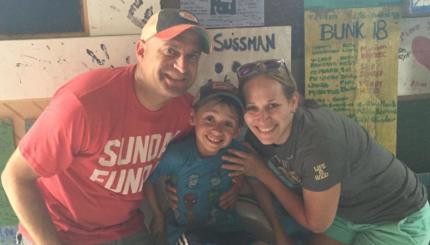I have a secret to share. Some of the most nonjudgmental and welcoming Jews I have ever met have been Hasidim. This surely defies all stereotypes of angry Jewish men in long black coats with shaved heads and peyot and big round fur hats shouting at Jews who dare to transgress their vision of what Jewish life should look like. We have seen the images in newspaper articles, TV newscasts and heard the descriptions from reporters on the radio. Hasidim are unwelcoming, inhospitable and unforgiving of difference. The only problem is, in my experience, that is not true.
My first intensive experience with Hasidim was living amongst them for a summer in the small town of Monticello in the Catskills. It was the summer after my first year of college and I heard from a college classmate and friend that a Hasidic summer camp was looking for male counselors. I did not have any other plans and the prospect of spending a summer immersed in the Hasidic community enthralled me.
I packed my bags and headed up to the mountains to live and work for the summer at a Hasidic bungalow colony that had an active summer camp for the children. The children were in heder, school, for most of the day and the camp only functioned for a few hours in between lessons. During the rest of the time I enjoyed many long and rich conversations with the people in the camp.
In the Beit Midrash, the study hall, of the bungalow colony I would sit with a study partner and learn the works of Rabbi Abraham Isaac Hakohen Kook and Rabbi Yisacher Shlomo Teichtal, two prominent early and mid 20th century rabbinic proponents of Jewish nationalistic expression in the Land of Israel. Even though this was in sharp disagreement with the prevailing philosophy of the Hasidim of the bungalow colony no one tried to change my views. Rather, we engaged in respectful and civil discussion about the Jewish state, Messianism and the Land of Israel.
In fact, respectful embrace of difference was the overwhelming feature of my two months with the Hasidim of Monticello. In a time currently of intense discord within Modern Orthodoxy on who is in and who is out, the tolerance for difference of the Hasidim is a lesson that merits to be taken to heart.
After my summer in Monticello I enjoyed many subsequent weekends in Hasidic enclaves such as Boro Park, Monsey, Kiryas Tosh in Quebec and Kiryas Joel in Monroe, New York.
During the Shabbat spent in Kiryas Joel with a friend and fellow classmate in rabbinical school we found ourselves in a Beit Midrash during the afternoon. We were studying the Torah commentary of Rabbi Yehuda Aryeh Leib Alter (1847-1905), the rebbe of the Hasidic dynasty of Ger. While we were learning a young Satmar Hasid walked in and saw us sitting in the Beit Midrash. With our short beards, knitted kippas and modern suits we clearly were not regulars. We struck up a conversation. We did our best in our limited Yiddish and limited English, respectively. We were surprised when he had heard of our Modern Orthodox yeshiva. He was surprised to find us in his town for Shabbat. As he left to join his study partner he turned to us and said: “Keep on doing avodas hakodesh (sacred work), teaching Torah to the modernisher oilam (the modern community).”
That single encounter on a long Shabbat afternoon in the remote village of Kiryas Joel sums up the embrace, warmth and respect of the Hasidim for others. In a time where all too often it is Jew vs. Jew this model is sorely needed.
Hasid
Pronounced: KHAH-seed, Origin: Hebrew, a Hasidic Jew, a follower of Hasidic Judaism, a stream within ultra-Orthodox Judaism that grew out of an 18th-century mystical revival.
Hasidic
Pronounced: khah-SID-ik, Origin: Hebrew, a stream within ultra-Orthodox Judaism that grew out of an 18th-century mystical revival movement.
Shabbat
Pronounced: shuh-BAHT or shah-BAHT, Origin: Hebrew, the Sabbath, from sundown Friday to sundown Saturday.
Torah
Pronunced: TORE-uh, Origin: Hebrew, the Five Books of Moses.
Yehuda
Pronounced: yuh-HOO-dah or yuh-hoo-DAH (oo as in boot), Origin: Hebrew, Judah, one of Joseph’s brothers in the Torah.


